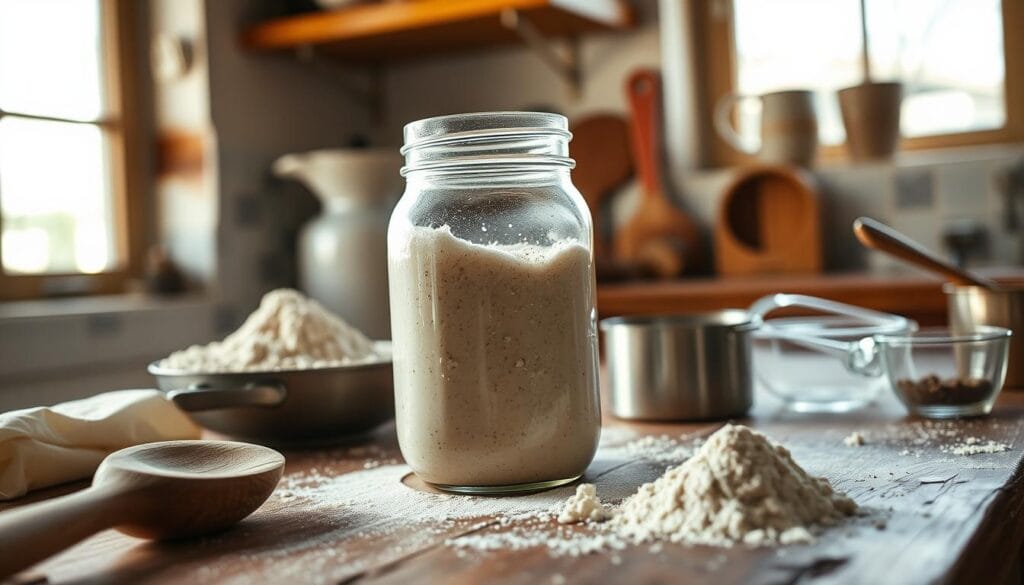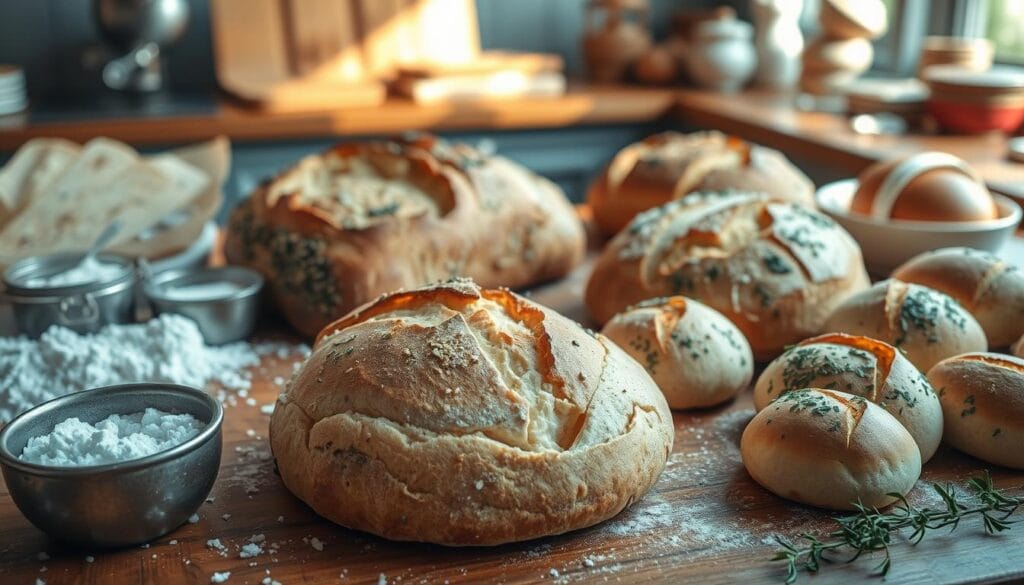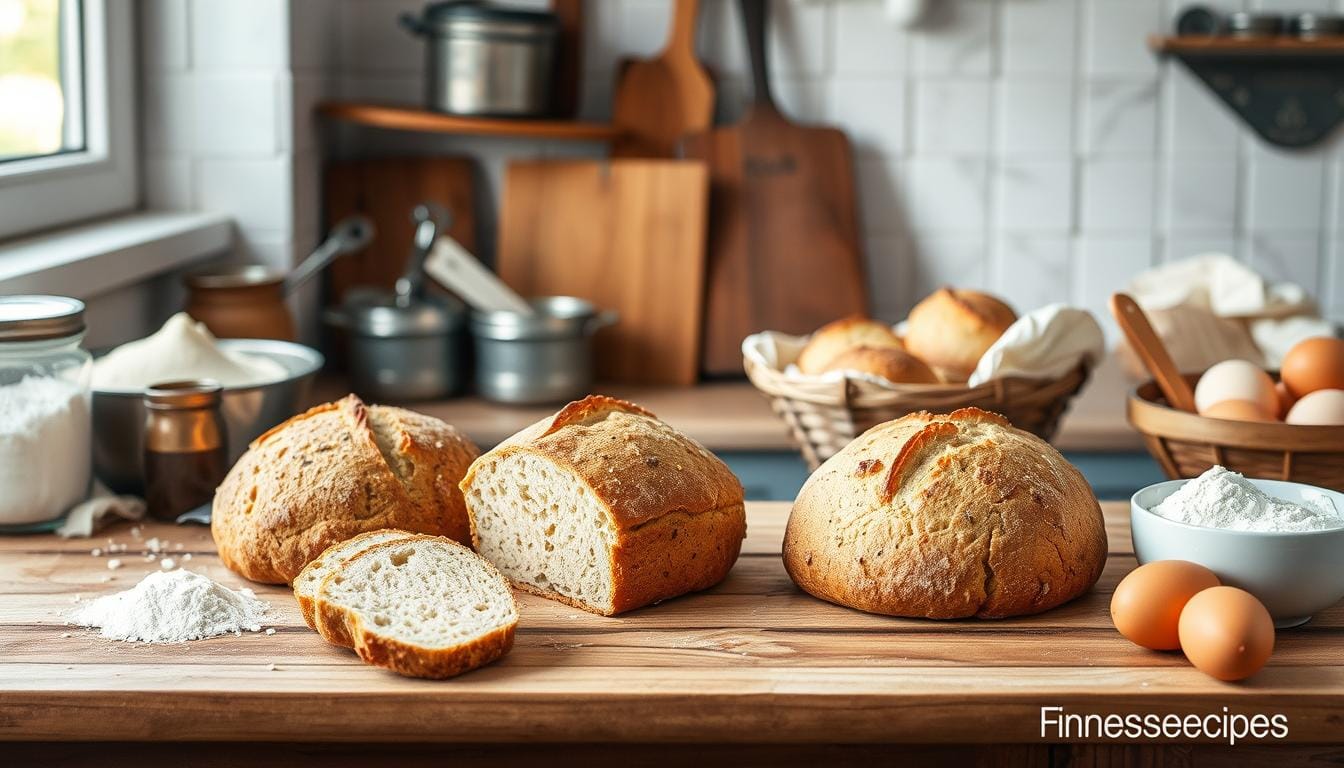Every weekend, I would look at the artisan bakery windows, dreaming of making perfect sourdough breads. The old ways seemed too hard — long waits, tricky steps, and secret fermentation. But then, I found sourdough quick bread recipes that changed everything.
Sourdough baking doesn’t have to be hard. Quick bread methods let you make tasty homemade sourdough fast. These recipes bring the sour taste and soft texture of sourdough to your home quickly.
Quick breads are great for anyone, whether you’re busy or just starting out. They show you how to make yummy loaves with little time and effort. You’ll learn simple ways to make artisan-style bread, making it easy for everyone.
Table des matières
Understanding Quick Sourdough Bread Fundamentals
Exploring artisan bread means learning about fermented doughs. Quick sourdough bread making makes long processes easy for home bakers. You start by learning key techniques that make bread making simpler.
The art of sourdough bread has changed, becoming easier for home bakers. With smart methods, you can cut down preparation time. Yet, you keep the true sourdough taste.
Benefits of Quick Fermentation Methods
- Reduces total preparation time from 10+ hours to under 4 hours
- Maintains rich, complex sourdough flavor
- Simplifies traditional fermentation processes
- Allows flexible scheduling for home bakers
Essential Equipment and Tools
Quick sourdough bread making needs just a few tools. Your kitchen should have:
- Large mixing bowl
- Digital kitchen scale
- Proofing basket
- Dutch oven or baking stone
- Sharp bread lame or razor
Basic Ingredients Overview
| Ingredient | Quantity | Purpose |
|---|---|---|
| Bread Flour | 2 cups | Provides protein structure |
| Whole Wheat Flour | 2 cups | Adds nutty flavor and nutrients |
| Active Sourdough Starter | 1 cup | Introduces fermentation |
| Water | 2 cups | Hydrates flour and activates fermentation |
| Sea Salt | 2 tablespoons | Enhances flavor |
« Sourdough bread is not just food; it’s a connection to traditional baking methods and natural fermentation. » – Artisan Baker
Knowing these basics lets you turn complex sourdough techniques into easy home baking.
The Science Behind Fast Sourdough Fermentation
Sourdough fermentation is a fascinating process. It turns simple ingredients into complex, flavorful bread. Learning about the science behind it can help you make quick sourdough and develop rich flavors.
The magic of sourdough comes from wild yeast and lactic acid bacteria. Unlike commercial bread, sourdough uses natural microorganisms like Saccharomyces exiguus and Lactobacillus sanfranciscensis.
« Temperature is the conductor of the fermentation orchestra » – Sourdough Experts
Several factors affect how fast fermentation happens:
- Starter percentage
- Dough hydration levels
- Ambient temperature
- Flour composition
Temperature is key to speeding up fermentation. Every 15°F increase doubles the rate. The best temperature for yeast activity is between 80°F and 90°F.
| Temperature Range | Fermentation Characteristics |
|---|---|
| 40°F – 55°F | Slow fermentation, enhanced flavor development |
| 70°F – 80°F | Moderate fermentation, balanced flavor |
| 80°F – 90°F | Rapid fermentation, increased metabolic activity |
Whole grain flours like rye add nutrients for faster fermentation. By understanding these scientific principles, you can make delicious sourdough bread quickly.
Sourdough Quick Bread Recipes for Beginners
Exploring sourdough quick bread recipes can change your baking at home. It’s great for new bakers or those wanting to improve their sourdough skills. These easy recipes will help you make tasty breads with little effort.
Classic No-Wait Sourdough Loaf
Start with a simple recipe for sourdough quick bread. This no-wait loaf gives you artisan-style bread fast. It uses a dough with 73% moisture for perfect texture and quick prep.
- Total preparation time: Just over 2 hours
- Initial rise time: Approximately 30 minutes
- Baking temperature: 475°F
- Baking duration: 25-35 minutes
Easy Sourdough Discard Bread
Turn leftover sourdough starter into a tasty bread. This recipe uses sourdough discard for a quick and delicious loaf. It’s perfect for beginners.
| Ingredient | Quantity |
|---|---|
| Flour | 2 cups |
| Sourdough Discard | 3/4 cup |
| Butter | 8 tablespoons |
| Sugar | 1 cup |
The recipe involves 3 stretch and folds at 15-minute intervals. This develops gluten without kneading.
Simple Cinnamon Sourdough Quick Bread
Make a sweet cinnamon bread with sourdough. It’s great for breakfast or an afternoon snack. This recipe shows how versatile sourdough quick bread can be.
« Baking is love made visible » – Unknown
- Baking temperature: 350°F
- Total time: Over 1 hour
- Cooling time: 20 minutes
- Baking time: 60-70 minutes
For the cinnamon swirl, mix 1 tablespoon of cinnamon with 1/2 cup of brown sugar. You can also make a glaze with 1/2 cup powdered sugar, 1 tablespoon water, and 1/8 teaspoon vanilla extract.
These sourdough quick bread recipes show that making homemade bread is easy for all bakers. With practice, you’ll get better at sourdough baking.
Working with High-Hydration Quick Doughs
Learning to make bread with high-hydration doughs can change your sourdough baking. These doughs have 80% or more water, making them very sticky and hard to work with.
It’s important to understand these wet doughs if you bake at home. They feel more like liquid than dough, which can be scary at first.
« The secret to high-hydration doughs is patience and technique, not strength, » says professional baker Michael Rodriguez.
Key Techniques for Managing Wet Doughs
- Use wet hands when handling the dough to prevent sticking
- Employ the stretch and fold method instead of traditional kneading
- Allow extended resting periods between manipulations
- Maintain consistent dough temperature
For high-hydration bread, handle the dough gently. The stretch and fold method is best. It helps the dough develop gluten without losing its air.
Hydration Level Considerations
| Hydration Percentage | Dough Characteristics |
|---|---|
| 74-80% | Moderate wetness, easier to handle |
| 80-85% | Very wet, requires advanced techniques |
| 85%+ | Extremely liquid, challenging manipulation |
Keep in mind that flour types affect how much water the dough absorbs. Whole wheat and rye flours need more water than regular bread flour. Try different amounts to find what works best for you.
Time-Saving Mixing and Folding Techniques
Learning to make sourdough bread is easier when you know how to mix and fold quickly. You don’t need to spend a lot of time on it. Just use the right methods.
Hand Mixing Methods
Professional bakers say hand mixing is an art in sourdough baking. Your hands are the best tools for feeling the dough. Here’s how to do it right:
- Mix ingredients until just combined
- Avoid overmixing to prevent tough bread
- Use a gentle folding motion to incorporate ingredients
Stretch and Fold Shortcuts
The stretch and fold technique makes sourdough baking faster. Here’s a quick guide:
| Technique | Duration | Frequency |
|---|---|---|
| Initial Stretch and Fold | 1.5-2 hours | 3-4 times |
| Interval Between Folds | 30 minutes | Consistent |
Proper Dough Temperature Control
Temperature is key in sourdough baking. Aim for a dough temperature around 75°F for best results. Warmer dough rises faster, while cooler dough rises slower.
« The secret to great bread is understanding your dough’s language. » – Artisan Baker
By using these quick techniques, you’ll make sourdough baking easy. You’ll get delicious bread with less effort.
Mastering the 50% Starter Method

The 50% starter method changes how you make sourdough bread. It makes the process faster and more efficient. This method cuts down on fermentation time but keeps the deep flavors of traditional sourdough.
To master the 50% starter method, you need to know the right proportions. Here’s a detailed guide:
- Use 50% of your active starter in the main dough
- Reduce overall fermentation time by 30-40%
- Maintain robust flavor profiles
- Create more consistent bread results
« Precision in sourdough is an art form balanced between science and intuition. »
When using this method, how you feed your starter is key. You’ll typically use:
| Ingredient | Quantity |
|---|---|
| Leftover Starter | 25 grams |
| Bread Flour | 50 grams |
| Water | 50 grams |
Your main dough will have 450 grams of bread flour, 300 grams of water, 100 grams of active sourdough starter, and 10 grams of salt. The goal is to keep your starter at 100% hydration for the best rise and texture.
Keeping your kitchen at 70-72°F is important for fermentation. By managing your sourdough starters with the 50% method, you’ll make tasty, quick breads with less effort.
Quick Sourdough Baking Tips and Troubleshooting
Sourdough baking can be tricky, but with the right tips, you’ll get the hang of it. Knowing how to fix common problems will make your sourdough better every time.
Common Quick Bread Issues
Quick sourdough breads can face specific problems. Here are some common ones:
- Dense and heavy loaves
- Uneven rising
- Lack of proper fermentation
- Inconsistent texture
Temperature and Timing Adjustments
Getting the temperature right is key in sourdough baking. Here are some important tips:
| Parameter | Recommended Range |
|---|---|
| Dough Fermentation Temperature | 76-78°F |
| First Rise Duration | 10-12 hours |
| Proofing Time After Shaping | 1-2 hours |
Storage and Preservation Methods
Storing your sourdough bread right keeps it fresh longer. Quick bread making techniques include:
- Room temperature storage: 1-2 days
- Freezing duration: Up to 2 months
- Wrap bread in parchment paper
- Store in a bread box or sealed container
« The secret to great sourdough is patience and practice. » – Artisan Baker
By using these sourdough baking tips, you’ll improve your bread making. You’ll make loaves that are always a delight.
Creative Variations for Quick Sourdough Breads
Exploring sourdough quick bread recipes is a fun journey. It lets you mix and match flavors to create something new. Artisan bread lovers can add special ingredients to make their bread stand out.

Adding certain ingredients can change your bread’s taste in amazing ways. Here are some ideas to try:
- Savory Combinations
- Jalapeño cheddar
- Roasted garlic and parmesan
- Italian herb with mozzarella
- Sweet Variations
- Chocolate chip
- Cinnamon swirl
- Honey and rosemary
Adding seeds to your bread can make it healthier. Sesame, flax, and pumpkin seeds are full of good stuff like calcium and iron.
« Creativity in baking is about experimenting with flavors that tell a story. » – Unknown Baker
Looking for ideas? Check out Pinterest and Instagram for sourdough inspiration. Your kitchen can become a place of endless creativity.
| Category | Recommended Ingredients | Flavor Profile |
|---|---|---|
| Cheese Lovers | Asiago, Sharp Cheddar | Rich, Tangy |
| Herb Garden | Fresh Dill, Rosemary | Aromatic, Fresh |
| Spicy Kick | Calabrian Chili | Bold, Intense |
Remember, baking is all about trying new things. Your special mix might just become the next big thing in artisan bread!
Conclusion
Exploring sourdough quick bread recipes opens a world of tasty possibilities. You can make amazing bread with little effort. These skills connect you to old cooking ways, adding flavor, nutrition, and joy to your kitchen.
Sourdough baking is an art that needs patience and creativity. It helps you use up food waste, make bread easier to digest, and create complex flavors. Each loaf is a step towards becoming a skilled home baker.
Begin with small steps and grow your skills slowly. Your sourdough journey is special, with each loaf teaching you something new. Practice, try different flours, and don’t worry about mistakes. Over time, you’ll understand sourdough and make incredible bread at home.
Keep learning and growing in sourdough baking. The techniques you’ve learned are just the start. Stay curious and enjoy the tasty results of your sourdough quick bread recipes.
FAQ
What are sourdough quick breads?
Do I need a special starter to make quick sourdough breads?
How can I use sourdough discard in quick bread recipes?
What equipment do I need to make sourdough quick breads?
Can I make gluten-free sourdough quick breads?
How long does it take to make a sourdough quick bread?
What types of flour work best for sourdough quick breads?
How do I know if my sourdough quick bread is properly fermented?
Can I add mix-ins to my sourdough quick bread?
How should I store sourdough quick breads?
Source Links
- Quick Sourdough Bread – https://natashasbaking.com/quick-sourdough-bread/
- Sourdough Discard Cinnamon Bread – Bread by the Hour – https://breadbythehour.com/sourdough-discard-cinnamon-quick-bread/
- Beginner’s Sourdough Bread Recipe – https://littlespoonfarm.com/sourdough-bread-recipe-beginners-guide/
- The Easiest Sourdough Bread Recipe: A Step-by-Step Guide for Beginners – https://balancedkitchen.com/2024/05/easiest-sourdough-bread-recipe/
- Classic King Arthur Sourdough Bread Recipe – https://chasingoursimple.com/classic-king-arthur-sourdough-bread-recipe/
- Simple Artisan Sourdough Bread Recipe – https://countryroadssourdough.com/simple-sourdough-bread-recipe/
- Sourdough Starter Fermentation Explained: How Wild Yeast and Bacteria – https://www.summitsourdough.com/blogs/information-and-process-5/science-of-sourdough-fermentation?srsltid=AfmBOoq7b04u8cXBmZ_UZP3-64GrTGIR9Bkd3AJsbTyujkK-SKg381HW
- Homemade Sourdough Bread: Times and Temperatures – https://blog.thermoworks.com/sourdough-bread-times-and-temperatures/
- No-knead Sourdough Discard Bread – Make It Dough – https://makeitdough.com/sourdough-discard-bread/
- Sourdough Discard Cinnamon Bread – https://www.farmhouseonboone.com/sourdough-discard-cinnamon-bread/
- Rustic Sourdough Bread – https://www.kingarthurbaking.com/recipes/rustic-sourdough-bread-recipe
- Easy High Hydration Sourdough Bread (No Unnecessary Steps) – Grant Bakes – https://grantbakes.com/easy-high-hydration-sourdough-bread/
- High Hydration Sourdough Bread Recipe – https://www.farmhouseonboone.com/high-hydration-sourdough-bread-recipe/
- Quick and Easy Sourdough Bread Recipe – Chefs Binge – https://chefsbinge.com/quick-and-easy-sourdough-bread-recipe/
- Speedy Same Day Sourdough Bread Recipe (Easy to Make) – https://stretchandfolds.com/speedy-same-day-sourdough-bread-recipe-easy-to-make/
- Same Day Sourdough Bread – https://countryroadssourdough.com/same-day-sourdough-bread/
- Good Sourdough Bread (My Master Sourdough Recipe) | Grant Bakes – https://grantbakes.com/good-sourdough-bread/
- Beginner’s Sourdough Bread | The Perfect Loaf – https://www.theperfectloaf.com/beginners-sourdough-bread/
- bread – The simplest way to make sourdough – https://foodbodsourdough.com/tag/bread/
- Easy Sourdough Bread Recipe – https://amybakesbread.com/easy-sourdough-bread-recipe/
- The Best Golden Sourdough Bread Recipe | Easy for Beginners – Simply Taralynn | Food & Lifestyle Blog – https://simplytaralynn.com/2024/12/23/the-best-sourdough-bread-recipe-easy-for-beginners/
- Mini Sourdough Bread Loaves – https://countryroadssourdough.com/mini-sourdough-bread-loaves/
- 51 Sourdough Inclusion Ideas: Add-Ins You Should Try – https://thatsourdoughgal.com/sourdough-inclusion-ideas/
- Easy Sourdough Bread Recipe – That Bread Lady – https://thatbreadlady.com/easy-sourdough-bread-recipe/
- Easy No-Knead Sourdough Bread Recipe for Beginner’s – https://idiesfarm.com/easy-no-knead-sourdough-bread-recipe-for-beginners/
- My Best Sourdough Recipe | The Perfect Loaf – https://www.theperfectloaf.com/best-sourdough-recipe/

